How to Grow Cantaloupes: Essential Tips for Sweet Success
- March 4, 2024
- 0 comment
Cantaloupes, also known as muskmelons, are a popular summertime treat renowned for their sweet, juicy flesh and refreshing taste. Growing cantaloupes can be a rewarding experience for both novice and experienced gardeners. This guide provides essential tips and techniques for cultivating delicious cantaloupes in your garden.
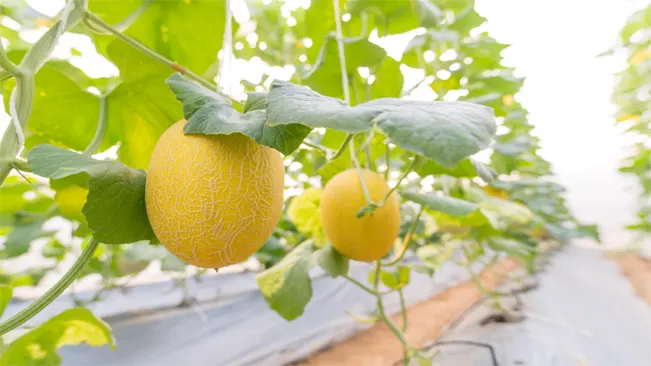
Nutritional Benefits of Cantaloupes
| Benefit | Description |
|---|---|
| Nutritional Value | High in vitamins A and C, potassium, and fiber. Low in calories, making it a healthy snack option. |
| Hydration | Consists of about 90% water, which helps in keeping the body hydrated. |
| Eye Health | Rich in beta-carotene, which converts to vitamin A and aids in maintaining good vision. |
| Immune System Support | The vitamin C content boosts the immune system, helping the body fight off infections. |
| Skin Health | Contains antioxidants and vitamin A that contribute to healthy skin. |
| Digestive Health | The dietary fiber in cantaloupe aids in digestion and promotes gut health. |
| Heart Health | Potassium helps in maintaining healthy blood pressure levels, supporting heart health. |
| Anti-inflammatory Properties | Contains phytochemicals and anti-inflammatory compounds that can help reduce inflammation in the body. |
| Cancer Risk Reduction | Antioxidants and other compounds in cantaloupes may help in reducing the risk of certain cancers. |
| Weight Management | Low in calories and high in fiber, making it a great option for weight management diets. |
List on How to Grow Cantaloupe
- Choosing the Right Variety
- Planting
- Watering and Fertilization
- Pest and Disease Management
- Pollination
- Support and Pruning
- Harvesting
Choosing the Right Variety
First, it’s important to select the right variety of cantaloupe for your climate and space. Varieties like ‘Athena’ and ‘Ambrosia’ are popular for their sweetness and disease resistance. Check with local nurseries or gardening groups to find the best variety for your area.
Athena
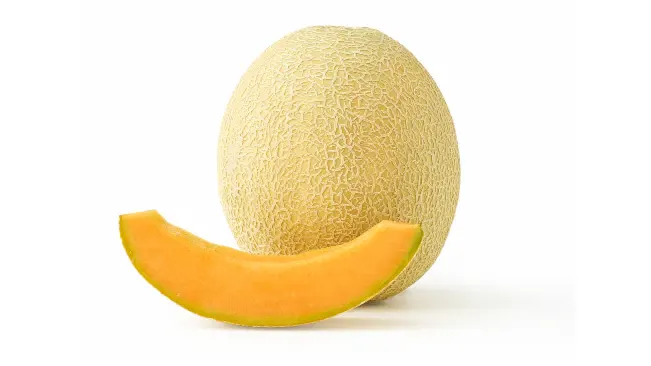
- This is a widely favored variety known for its exceptional sweetness and musky aroma. Athena cantaloupes are typically large, with a heavily netted, firm rind. They are resilient against common melon diseases and have a relatively short growing period, making them suitable for a variety of climates.
Ambrosia
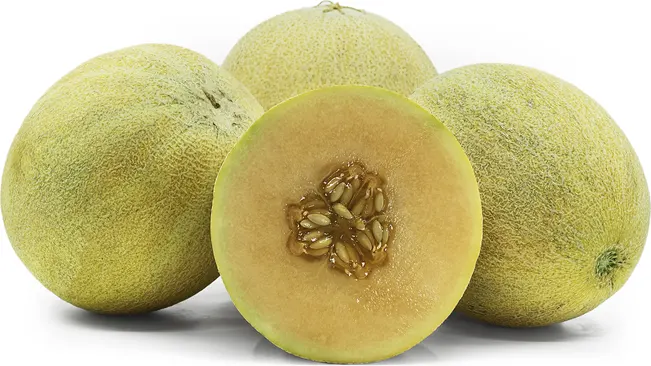
- Another popular choice, Ambrosia cantaloupes are known for their super sweet flavor and smooth texture. The fruits are smaller than Athena but equally aromatic. They have a thin rind with a distinct netting pattern. Ambrosia is also resistant to some diseases, but it may require a bit more care in terms of climate and soil conditions.
Choosing Based on Climate and Space
- Warm Climates: In warmer regions, you have a wider selection of varieties. Look for ones that can tolerate heat and have a longer growing season.
- Cooler Climates: Opt for fast-maturing varieties that can produce fruit before the cooler temperatures of early fall set in.
- Limited Space: If you’re working with limited space or a container garden, look for compact or bush-type varieties. These plants are bred to take up less space while still producing full-sized fruits.
Consult Local Sources
- Local Nurseries and Garden Centers: They often stock varieties that perform well in your area’s climate and soil conditions.
- Agricultural Extensions: These can be a goldmine of information. Many extensions provide region-specific planting guides, including recommended cantaloupe varieties.
- Gardening Groups and Clubs: Fellow gardeners can offer invaluable advice based on their personal experiences in your area.
Planting
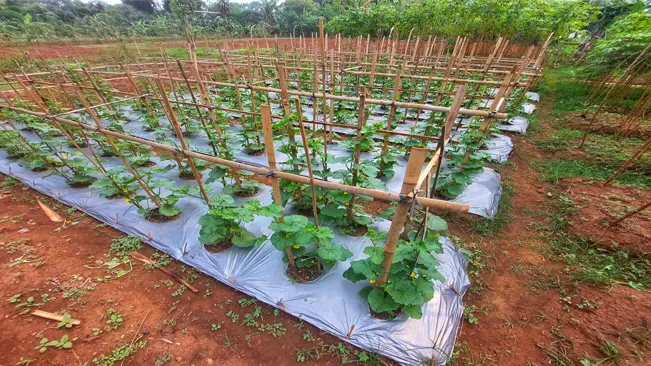
- Choosing the Right Spot
The location for planting cantaloupes is crucial. They need a spot in your garden that receives full sunlight for most of the day. This is important because cantaloupes, like most melons, develop their best flavor and sweetness when they receive plenty of warmth and sunlight. - Preparing the Soil
Cantaloupes prefer well-draining soil, as standing water can lead to root rot and other diseases. Before planting, it’s beneficial to prepare the soil by adding organic matter like compost or well-rotted manure. This not only improves drainage but also adds nutrients to the soil. A soil pH between 6.0 and 6.8 is ideal for cantaloupes. - Starting Seeds Indoors
In regions with short growing seasons, starting seeds indoors can give your cantaloupes a head start. Plant the seeds in peat pots or small containers about 3-4 weeks before the expected last frost date. Keep the soil moist and provide them with plenty of light and warmth. This early start is important because cantaloupes need a long growing season to mature. - Transplanting Seedlings
When transplanting seedlings outdoors, it’s crucial to wait until the danger of frost has passed and the soil has warmed up. Gradually acclimate the seedlings to outdoor conditions over a week (this process is known as hardening off) to prevent shock. When you’re ready to transplant, be gentle with the roots to avoid damage. - Direct Sowing
If you prefer to sow the seeds directly in the garden, do so after the last frost. Plant 2-3 seeds in mounds about 36 to 42 inches apart. The mounds should be spaced about 4-6 feet apart. This spacing allows the vines room to spread out and prevents overcrowding, which can lead to poor air circulation and disease. - Nutrient-Rich Soil
Cantaloupes are heavy feeders, so nutrient-rich soil is vital. In addition to adding organic matter before planting, consider applying a balanced fertilizer at planting time. Once the plants are established and the melons start to grow, a lower nitrogen fertilizer is preferable to encourage fruit development over leaf growth. - Watering Considerations
While cantaloupes need regular watering, especially during germination and early growth, it’s important to avoid overwatering. The soil should be moist but not soggy. Once the fruit starts to develop, you can reduce watering to concentrate sugars in the fruit, but don’t let the plants completely dry out.
Watering and Fertilization
Watering Cantaloupes
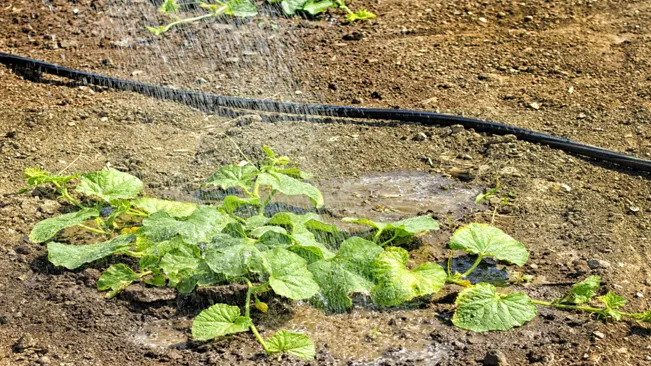
- Consistent Moisture is Key: Cantaloupes require regular and consistent watering, particularly during their growing and fruit-setting stages. This consistency is vital for the development of healthy, juicy fruits.
- Amount of Water: The general rule of thumb is to provide about 1 to 2 inches of water per week. However, this can vary depending on your climate and weather conditions. Hotter, drier climates may necessitate more frequent watering.
- Method of Watering: Drip irrigation is highly recommended for cantaloupes. This system delivers water directly to the roots, minimizing water waste and preventing the leaves from getting wet, which can reduce the risk of fungal diseases.
- Timing: Watering in the early morning is ideal as it allows the water to seep into the soil before the heat of the day can cause evaporation. It also helps the leaves to dry out quickly if they get wet, again reducing the risk of disease.
- Soil Moisture: It’s important to keep the soil consistently moist but not waterlogged. Overwatering can lead to root rot and other diseases. Using mulch around the plants can help retain soil moisture and regulate temperature.
Fertilizing Cantaloupes
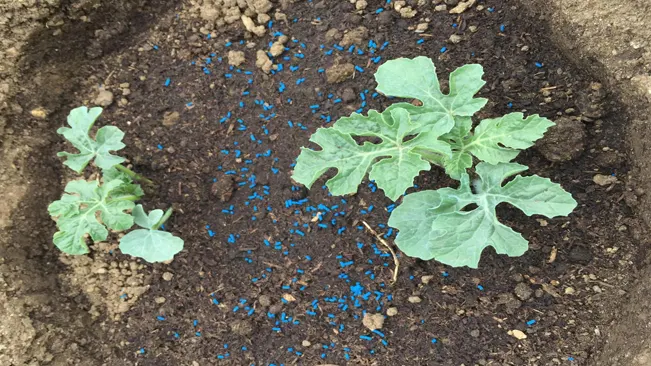
- Initial Fertilization: When planting cantaloupes, use a balanced fertilizer, like a 10-10-10 (nitrogen, phosphorus, potassium) mix. This initial fertilization provides essential nutrients to support early growth.
- Fertilization During Fruiting: As the plants start to flower and set fruit, switch to a fertilizer that’s higher in phosphorus and potassium. This shift supports fruit development and can enhance the sweetness and size of the cantaloupes.
- Application Frequency: Fertilize about once every 4-6 weeks during the growing season. However, be sure to follow the instructions on the specific fertilizer you’re using, as over-fertilization can be harmful.
- Organic Options: For those who prefer organic gardening, compost or well-rotted manure can be great alternatives to commercial fertilizers. They add nutrients to the soil and improve its structure.
- Avoiding Nitrogen Overload: Be cautious with high nitrogen fertilizers, especially in the later stages of growth. Excess nitrogen can lead to lush vine growth at the expense of fruit development.
Pest and Disease Management
Pest Management
- Cucumber Beetles: These are one of the most common pests affecting cantaloupes. They not only feed on leaves and stems but also transmit bacterial wilt, which can be devastating to the plants.
- Control: Use floating row covers to protect the plants, especially during the early growth stages. If beetle populations are high, you might need to use insecticides. Always choose insecticides that are effective yet have minimal impact on beneficial insects and the environment.
- Aphids: These small insects can cause damage by sucking sap from the plants, leading to distorted growth and potentially transmitting diseases.
- Control: Natural predators like ladybugs can help control aphid populations. In severe cases, insecticidal soaps or oils can be used.
- Spider Mites: These tiny pests can cause significant damage by feeding on plant sap, leading to yellowing and stippling of leaves.
- Control: Increasing humidity and using forceful water sprays can reduce mite populations. Insecticidal soaps or miticides may also be necessary in severe cases.
Disease Management
- Powdery Mildew: This fungal disease appears as white, powdery spots on leaves and can lead to leaf drop and reduced fruit quality.
- Control: Ensure good air circulation around plants and avoid overhead watering to reduce humidity. Fungicides can be used for control, but it’s important to apply them at the first sign of disease.
- Downy Mildew: This is another fungal disease that causes yellow spots on leaves and can lead to premature leaf drop.
- Control: Similar to powdery mildew, good air circulation and reduced leaf wetness are crucial. Fungicidal treatments may be necessary in persistent cases.
- Bacterial Wilt: Transmitted by cucumber beetles, this disease causes plants to wilt and die rapidly.
- Control: The best approach is prevention, primarily by controlling cucumber beetle populations. Remove and destroy affected plants to prevent the spread of the disease.
Pollination
Cantaloupes require pollination to produce fruit. If you have a low bee population in your area, you may need to hand pollinate. This involves transferring pollen from male flowers to female flowers using a small brush or your finger.
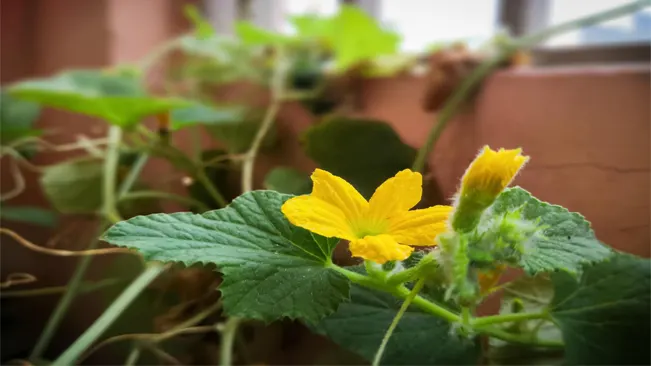
The Role of Bees in Pollination
In a natural setting, bees are the primary pollinators of cantaloupes. They transfer pollen from male flowers to female flowers as they move from plant to plant, searching for nectar. This pollen transfer is essential for the fertilization of the female flowers, leading to fruit development.
Hand Pollination
In areas with low bee populations or in controlled environments like greenhouses, hand pollination becomes necessary. Here’s how to do it:
- Identify the Flowers: In the morning, identify open male and female flowers. The male flowers will be on longer, thinner stems, while female flowers will have the small swelling (future fruit) at the base.
- Collect Pollen: Gently brush the inside of a male flower with a small, soft brush or use your finger to collect the pollen. The pollen is a yellow, powdery substance inside the flower.
- Transfer Pollen: Carefully dab the pollen onto the center of the female flower. Try to mimic the natural pollination process by lightly brushing the pollen over the stigma of the female flower.
- Repeat the Process: Continue this process with other flowers, using fresh pollen from male flowers each time.
Support and Pruning
As the vines grow, providing support can help keep the fruit clean and prevent rot. Use trellises or slings to support the growing melons. Pruning excess growth can also improve air circulation and sun exposure, which are vital for healthy fruit development.
Support
Cantaloupe vines spread out considerably and can take up a lot of space in the garden. As the fruits grow, they become heavy and may touch the ground, making them susceptible to pests, diseases, and rot. Providing support for the growing vines and fruits helps alleviate these issues.
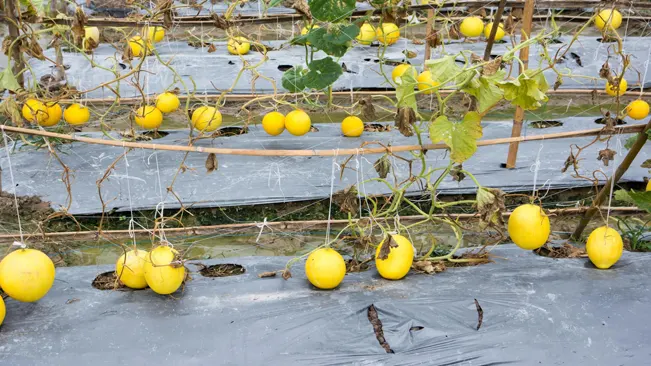
- Trellises: These are vertical structures that vines can climb. Using trellises for cantaloupes has several benefits:
- Elevates the fruit off the ground, reducing the risk of rot and pest attacks.
- Saves space in the garden, allowing for more efficient use of the area.
- Makes harvesting easier since the fruits are more visible and accessible.
- Slings: As cantaloupes grow heavier, they might need additional support to prevent them from falling off the trellis. Slings can be made from materials like pantyhose, soft cloth, or netting. They cradle the fruit, distributing its weight evenly and preventing stress on the vine.
Pruning
Pruning is another important aspect of growing cantaloupes. It helps in managing the growth of the plant and ensures better quality fruit.
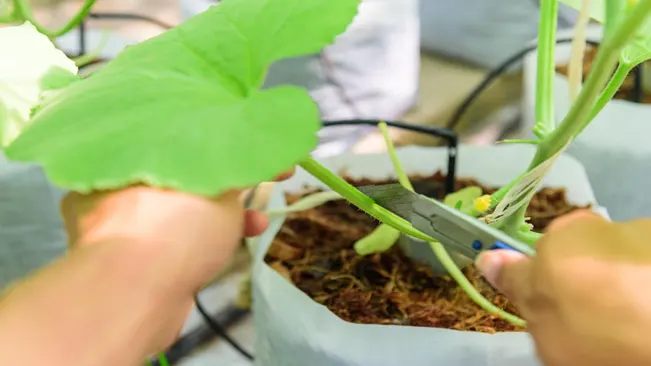
- Why Prune: Cantaloupe plants can produce more vines and flowers than they can support. Pruning helps in:
- Directing the plant’s energy towards the growth of a few healthy fruits rather than many mediocre ones.
- Improving air circulation around the plant, reducing the risk of fungal diseases.
- Ensuring better sun exposure, which is crucial for the fruit’s growth and sweetness.
- How to Prune:
- Identify the main vines and a few healthy secondary vines to keep.
- Remove any small or weak vines, especially those growing away from the trellis or support system.
- Prune off any dead or diseased leaves and vines as soon as they are spotted.
- Once a few fruits (typically 3-4 per plant) have begun to develop, prune off new flowering shoots to concentrate the plant’s energy on the existing fruits.
Harvesting
Cantaloupes are ready to harvest when the stem easily separates from the fruit, and the melon exhibits a sweet fragrance. The color of the fruit should change from green to a yellowish hue. Gently twist the melon; if it comes off easily, it’s ripe.
Understanding Ripeness
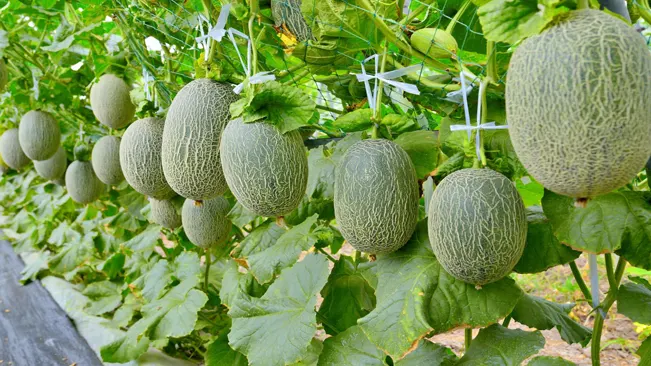
- Color Change: As cantaloupes ripen, their skin color changes significantly. Unripe cantaloupes have a greenish hue, but as they mature, the color shifts to a creamy, yellowish tone. This color change is one of the most reliable indicators of ripeness.
- Fragrance: Ripe cantaloupes emit a sweet, musky aroma. This fragrance is a result of the natural sugars in the fruit developing as it matures. You can often smell this scent near the blossom end (opposite the stem) of the melon.
- Stem Attachment: In a ripe cantaloupe, the stem end will begin to crack and the connection between the melon and the vine weakens. This is known as “slipping,” and it means the cantaloupe is ready to harvest. The fruit should easily come off the vine with a gentle tug or twist.
Harvesting Technique
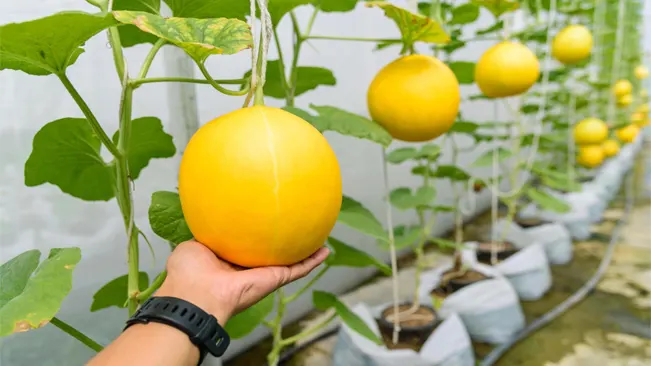
- Gentle Handling: Handle cantaloupes gently when checking for ripeness and during harvesting. Rough handling can bruise the fruit, impacting its quality and shelf life.
- Twisting Method: To harvest, hold the fruit in one hand and gently twist it. If the melon is ripe, it should detach easily from the vine. If you have to pull hard, it’s likely not ready.
- Morning Harvest: It’s often best to harvest cantaloupes in the morning when the temperatures are cooler. This can help in retaining the fruit’s freshness.
Post-Harvest Tips
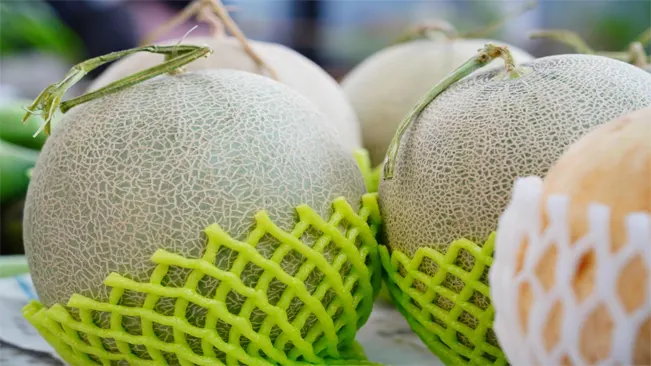
- Immediate Consumption: Cantaloupes harvested at peak ripeness are best consumed soon after picking for the best flavor and texture.
- Storage: If you need to store them, keep ripe cantaloupes in the refrigerator. This can help in preserving their quality for a few days.
- Ripening After Harvest: Cantaloupes generally do not continue to ripen significantly after they are detached from the vine, unlike some other fruits. So, it’s important to pick them when they are just right.
- Avoiding Overripe Melons: Overripe cantaloupes can become mushy and lose their flavor. If a melon feels overly soft or has areas that are sunken in, it may be past its prime.
Conclusion
Growing cantaloupes can be a delightful addition to your summer garden. With proper care, the right variety, and a little patience, you can enjoy the sweet rewards of your labor. Remember, the key to successful cantaloupe cultivation lies in consistent care and monitoring. Happy gardening!
FAQs (Frequently Asked Questions)
- When is the best time to plant cantaloupes?
- Plant cantaloupes after the last frost when the soil has warmed up, typically in late spring or early summer.
- Plant cantaloupes after the last frost when the soil has warmed up, typically in late spring or early summer.
- How much space do cantaloupe plants need?
- Space cantaloupe plants about 36 to 42 inches apart. They need room to spread out as the vines can grow quite large.
- Space cantaloupe plants about 36 to 42 inches apart. They need room to spread out as the vines can grow quite large.
- Do cantaloupes need a lot of sunlight?
- Yes, cantaloupes require full sun, meaning at least 6-8 hours of direct sunlight per day.
- Yes, cantaloupes require full sun, meaning at least 6-8 hours of direct sunlight per day.
- What type of soil is best for growing cantaloupes?
- Cantaloupes thrive in well-drained, nutrient-rich soil with a pH between 6.0 and 6.8.
- Cantaloupes thrive in well-drained, nutrient-rich soil with a pH between 6.0 and 6.8.
- How often should I water cantaloupe plants?
- Water regularly, keeping the soil consistently moist but not waterlogged. Reduce watering once the fruit begins to mature.
- Water regularly, keeping the soil consistently moist but not waterlogged. Reduce watering once the fruit begins to mature.
- Do I need to fertilize cantaloupe plants?
- Yes, use a balanced fertilizer at planting and then switch to a phosphorus and potassium-rich fertilizer during fruit development.
- Yes, use a balanced fertilizer at planting and then switch to a phosphorus and potassium-rich fertilizer during fruit development.
- How do I know when cantaloupes are ripe and ready to pick?
- Cantaloupes are ripe when the stem easily separates from the fruit, the skin turns a yellowish color, and the fruit emits a sweet fragrance.
- Cantaloupes are ripe when the stem easily separates from the fruit, the skin turns a yellowish color, and the fruit emits a sweet fragrance.
- Do cantaloupes require pollination?
- Yes, they require pollination. If bee activity is low, you may need to hand pollinate by transferring pollen from male to female flowers.
- Yes, they require pollination. If bee activity is low, you may need to hand pollinate by transferring pollen from male to female flowers.
- How do I protect cantaloupes from pests and diseases?
- Keep the area free of weeds and debris, use appropriate insecticides and fungicides, and practice crop rotation to prevent diseases.
- Keep the area free of weeds and debris, use appropriate insecticides and fungicides, and practice crop rotation to prevent diseases.
- Can I grow cantaloupes in containers?
- Yes, cantaloupes can be grown in large containers, but ensure they have enough space and support for the spreading vines.

Kristine Moore
Forestry AuthorI'm Kristine Moore, a seasoned garden landscaping professional with over 30 years of experience. My extensive career has been dedicated to transforming outdoor spaces into stunning, sustainable landscapes. With a deep understanding of horticulture, design principles, and environmental stewardship, I have become a respected figure in the field, known for creating harmonious, visually appealing, and eco-friendly gardens. My commitment to excellence and continuous learning in landscaping trends and techniques has solidified my reputation as an expert in garden design and implementation.

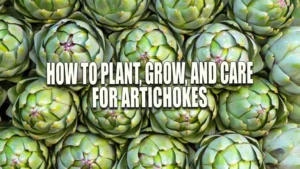



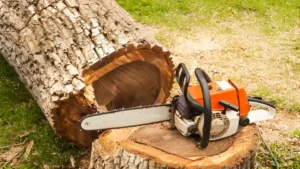

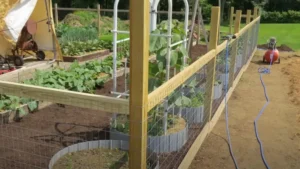



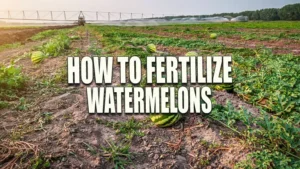

Leave your comment